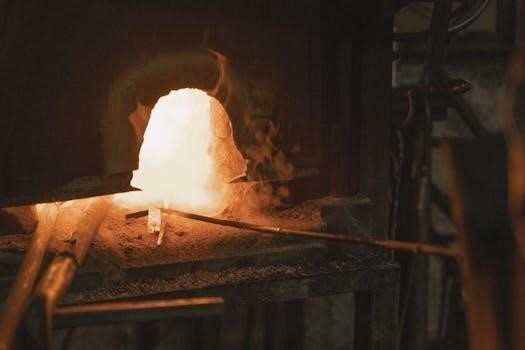
Manual Recliner vs. Power Recliner⁚ An In-Depth Comparison
Choosing between a manual and power recliner involves weighing convenience‚ cost‚ and features. Manual recliners operate by hand‚ while power models use electricity. This comparison explores the pros and cons of each‚ helping you decide which fits your needs‚ lifestyle‚ and budget best.

Defining Manual and Power Recliners
Manual recliners are classic seating options that rely on the user’s physical effort to adjust the reclining position. These chairs typically feature a lever or handle that‚ when activated‚ releases the reclining mechanism. The user then applies their body weight to lean back‚ engaging the footrest and adjusting the backrest to the desired angle. Manual recliners offer simplicity and affordability‚ making them a popular choice for many households. They don’t require electricity‚ providing flexibility in placement within a room.
Power recliners‚ on the other hand‚ utilize an electric motor to control the reclining function. With the simple push of a button‚ users can effortlessly adjust the chair to various positions‚ including fully reclined or lifted for assistance in standing. Power recliners often come with additional features such as heat and massage‚ enhancing the overall relaxation experience. While they offer greater convenience and customizable comfort‚ power recliners require a nearby power outlet for operation.
How Manual Recliners Work
The mechanics of a manual recliner are relatively straightforward. These recliners operate through a system of levers‚ springs‚ and hinges that work in tandem. Typically‚ a lever or handle is located on the side of the chair. When the user pulls this lever‚ it disengages a locking mechanism‚ allowing the chair to recline.
To recline‚ the user must then exert their own body weight and push back against the chair. This action extends the footrest and lowers the backrest simultaneously. The degree of recline is determined by how far back the user pushes and the number of locking positions available in the mechanism. Some manual recliners offer only a few set reclining positions‚ while others allow for more flexibility. Returning the chair to its upright position involves a similar process⁚ the user pushes the footrest back into place with their legs‚ which also raises the backrest. The simplicity of this system contributes to the manual recliner’s reliability and lower cost.
How Power Recliners Work
Power recliners employ an electric motor to control the reclining motion. These recliners must be plugged into a power outlet to function‚ although some models feature battery backup for use during power outages. Operation is managed through buttons typically located on the chair’s side or armrest. Pressing these buttons activates the motor‚ which then drives the reclining mechanism.
Unlike manual recliners‚ power recliners offer smooth‚ gradual movement and nearly infinite reclining positions. Users can stop the chair at any desired angle with the push of a button‚ providing personalized comfort. Many power recliners also include additional features like power headrests and lumbar support‚ all adjustable via the control panel. The electric motor does the work‚ eliminating the need for the user to exert any physical effort. This makes power recliners particularly beneficial for individuals with limited mobility or strength. The complexity of the motorized system contributes to the higher cost and potential for more intricate repairs.
Cost Comparison⁚ Manual vs. Power

When comparing manual and power recliners‚ cost is a significant consideration. Manual recliners generally have a lower initial purchase price. Their simpler design and lack of electrical components contribute to their affordability. This makes them an attractive option for budget-conscious buyers or those furnishing a space where a recliner is needed but not a primary investment piece.
Power recliners‚ on the other hand‚ typically command a higher price tag. The inclusion of an electric motor‚ more complex mechanisms‚ and additional features such as heat and massage contribute to the increased cost. Furthermore‚ potential repair costs should be considered. Power recliners have more intricate systems‚ meaning repairs can be more expensive than those for manual recliners. While power recliners offer enhanced convenience and features‚ the initial investment and potential maintenance expenses are factors to weigh against the benefits. Ultimately‚ the “better” option depends on individual budget constraints and prioritization of features.
Convenience and Ease of Use
The convenience and ease of use offered by manual and power recliners differ significantly. Manual recliners require physical effort to recline. Users typically engage a lever or push against the backrest‚ using body weight to achieve the desired position. This can be challenging for individuals with limited mobility or strength.
Power recliners excel in convenience. With the simple push of a button‚ users can effortlessly recline to their preferred angle. This is especially beneficial for those with disabilities‚ elderly individuals‚ or anyone seeking maximum comfort with minimal exertion. The smooth‚ controlled motion of a power recliner also allows for precise adjustments‚ finding that perfect sweet spot for relaxation. While manual recliners offer simplicity‚ power recliners prioritize ease of use‚ making them a more accessible and convenient option for a wider range of users. The push-button operation eliminates the need for physical strain‚ enhancing the overall lounging experience.

Reclining Positions and Control
The level of control and available reclining positions are key differentiators between manual and power recliners. Manual recliners typically offer a limited number of pre-set reclining positions. Users can usually choose between fully upright‚ partially reclined‚ and fully reclined. The locking mechanism restricts adjustments to these specific positions‚ potentially limiting personalized comfort.
Power recliners‚ on the other hand‚ provide a virtually infinite range of reclining positions. With the push of a button‚ users can precisely adjust the backrest and footrest to any desired angle. This allows for customized comfort and support‚ catering to individual preferences. Some power recliners also offer independent headrest and lumbar support adjustments‚ further enhancing the level of control. The ability to fine-tune the reclining position makes power recliners ideal for activities such as reading‚ watching television‚ or napping. The precise control and personalized comfort offered by power recliners provide a superior lounging experience compared to the limited options of manual models.
Power Source and Placement Considerations
A crucial aspect differentiating power and manual recliners lies in their power source requirements‚ directly influencing placement options within a room. Power recliners necessitate proximity to an electrical outlet to function‚ restricting placement choices. The power cord must reach an outlet‚ potentially requiring extension cords‚ which can be unsightly or pose tripping hazards. Although some power recliners incorporate battery backup features‚ these are primarily intended for temporary use during power outages‚ not as a primary power source.
Manual recliners offer greater placement flexibility as they do not require electrical power. These can be positioned anywhere in a room‚ unconstrained by outlet locations. This freedom is advantageous in spaces with limited outlets or when aiming for a clean‚ uncluttered aesthetic. The absence of cords also eliminates tripping hazards‚ making manual recliners suitable for households with children or elderly individuals. The placement freedom afforded by manual recliners offers a significant advantage for those prioritizing versatility and safety in their living space.
Durability and Maintenance
When evaluating recliners‚ durability and maintenance are crucial factors ensuring long-term satisfaction. Manual recliners generally boast simpler designs with fewer moving parts‚ potentially leading to greater longevity and reduced maintenance needs. Their mechanical components are often easier to repair or replace‚ resulting in lower repair costs. However‚ the manual reclining mechanism can experience wear and tear over time‚ requiring occasional adjustments or lubrication.
Power recliners‚ with their intricate electrical and mechanical systems‚ may present more complex maintenance challenges. The motors‚ wiring‚ and electronic controls are susceptible to failure‚ potentially requiring professional repairs. While power recliners offer enhanced convenience‚ their sophisticated components can be more costly to fix or replace. Regular cleaning and careful use can extend the lifespan of both types of recliners. Consider the long-term maintenance implications when deciding between a manual and power recliner‚ balancing convenience with potential repair expenses and complexities.

Additional Features⁚ Heat and Massage
Beyond the basic reclining function‚ many recliners offer additional features like heat and massage to enhance comfort and relaxation. These features are predominantly found in power recliners due to their electrical components. Integrated heating elements provide soothing warmth‚ easing muscle tension and promoting relaxation‚ while massage functions offer therapeutic benefits‚ targeting specific areas of the body.
Manual recliners typically lack these advanced features due to their reliance on manual operation. However‚ some manual models may offer limited massage functionality through built-in rollers or vibrating mechanisms‚ though these are less common and often less sophisticated than those found in power recliners. The inclusion of heat and massage can significantly elevate the lounging experience‚ making power recliners a desirable choice for individuals seeking ultimate relaxation and therapeutic benefits. Consider whether these additional features are essential to your comfort preferences when choosing between a manual and power recliner.
Aesthetic Differences and Design
While both manual and power recliners offer a wide range of styles‚ subtle aesthetic differences often distinguish them; Manual recliners tend to have a more traditional and streamlined design‚ often prioritizing simplicity and functionality. They may feature exposed levers or handles for operation‚ which can contribute to their overall look.
Power recliners‚ on the other hand‚ often boast a more contemporary and tech-savvy aesthetic. The absence of external levers creates a cleaner‚ more seamless appearance. Power recliners may also incorporate additional design elements such as integrated cup holders‚ USB charging ports‚ and LED lighting‚ further enhancing their modern appeal;
The design considerations also extend to the overall silhouette of the recliner. Manual recliners are sometimes lighter and easier to move. Ultimately‚ the choice between a manual and power recliner depends on individual aesthetic preferences and the desired style of the living space. Both offer a range of upholstery options‚ colors‚ and design details to complement any décor.
Pros and Cons Summary
Manual Recliners⁚
Pros⁚ Lower initial cost‚ no reliance on power outlets allowing flexible placement‚ lighter and easier to move‚ simpler design potentially leading to easier repairs.
Cons⁚ Requires physical effort to recline‚ fewer reclining positions‚ may lack advanced features like heat or massage‚ manual operation may be difficult for individuals with limited mobility.
Power Recliners⁚
Pros⁚ Effortless reclining with push-button operation‚ infinite reclining positions for customized comfort‚ often includes additional features such as heat and massage‚ easier to operate for individuals with mobility issues‚ modern aesthetic with seamless design.
Cons⁚ Higher initial cost‚ requires proximity to a power outlet‚ heavier and more difficult to move‚ more complex design potentially leading to more expensive repairs‚ dependence on electricity; inoperable during power outages without a battery backup;
Ultimately‚ the ideal choice hinges on balancing budget‚ convenience‚ desired features‚ and physical capabilities.